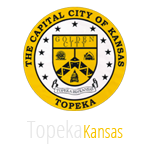Much of the infrastructure used to provide water to your home is located beneath the ground. It might be difficult for customers to determine what they are responsible for and what Topeka Water is responsible for. The following are descriptions and illustrations of some of the plumbing fittings, piping and equipment used to provide water service from the City’s main to your property.
Service Line
City Maintained & Owned Service Line Segment
All water service lines from the water main to the water meter located in the city’s right-of-way or city or public utility easement shall be the responsibility of the water division.
Customer Maintained & Owned Service Line Segment
The waterlines from the water meter to the structure, premises or yard hydrant being served or any portion of waterline on private property shall be the responsibility of the property owner. All waterlines from the water main to the water meter which are not located in the city’s right-of-way or city or public utility easement shall be the responsibility of the property owner.
Meter Box, Meter Setup & Meter
The City owns and maintains the meter box, meter box ring and cover, meter set-up (which includes the City valve located between the meter and the main and the Customer’s valve located between the meter and the building), meter and meter appurtenances.
The customer is responsible for the care of meter box, meter box ring and cover, meter set-up, meter and meter appurtenances. If a customer permits or allows a water meter, meter components or meter box to be damaged, impaired or destroyed by any means so that the meter and/or meter box must be repaired or replaced, the City shall bill and collect from the customer the cost of such repair or replacement. Allowing a water meter, box or its components to be damaged or destroyed by freezing, landscaping or vehicular traffic, theft, vandalism, and/or fire shall always be considered the liability of the customer. This list is not all-inclusive. The meter box and components must have a free and unobstructed access at all times.
Backflow Preventer
When installed, it is a device designed to prevent a potential backflow of contaminants from the customer’s property into the City’s distribution system. A backflow prevention device is owned, installed and maintained by the property owner.
Water Pressure Appurtenances
Low Pressure
In an area where water pressure is less than 40 psi, the homeowner/builder shall be responsible for the purchase and installation of a booster pump (a.k.a. jockey pump) to increase the pressure to at least 40 psi; maintenance and repair of the booster pump shall be the responsibility of the homeowner.
High Pressure
A Pressure Reducing Valve (PRV) shall be installed when water pressure exceeds the psi amount indicated as excessive per the Uniform Plumbing Code (UPC), and any amendments thereto, as adopted by the City of Topeka. The homeowner/builder shall be responsible for the purchase and installation of the PRV; maintenance and repair of the PRV shall be the responsibility of the homeowner.
Flushing a Service Line
In the event of a disruption in water service, please visit KDHE’s Consumer Information page for instructions on how to properly flush your service connection.
